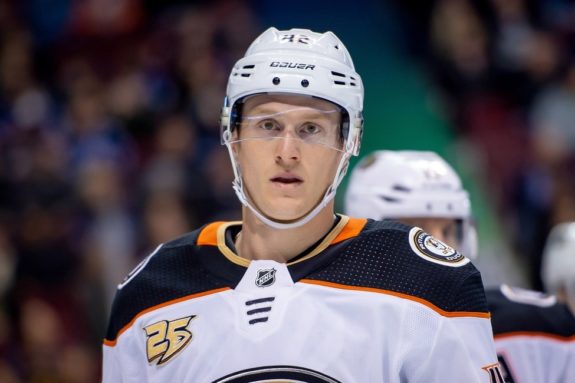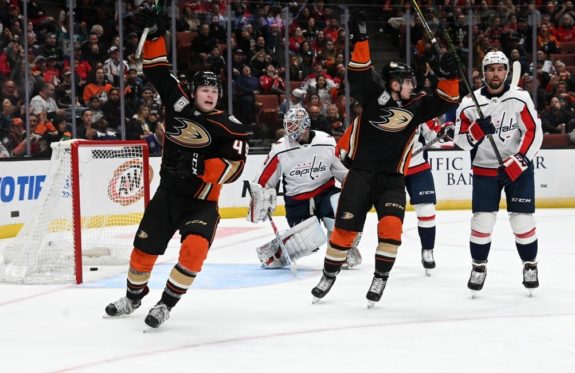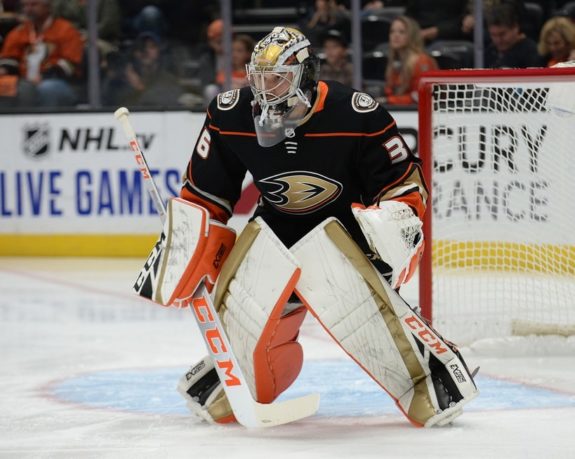The Anaheim Ducks provided fans with a reason for hope in October. Their demanding schedule and rigorous travel didn’t stop them from finishing the month with a better than .500 record. Halfway through November, things have gone downhill. Injuries to the defensive corps have exposed an already weak blue line and forced young players and part-time NHLers to pull in the slack.
The young up-and-comers on offense are showing some development, but also their lack of experience. The team continues to take foolish penalties and John Gibson isn’t himself. With more of the NHL’s heavy hitters both literally and figuratively looming on the horizon, maybe it’s time to worry about the Ducks remaining competitive past Thanksgiving.
Ducks Defense in a Wheelchair
Canadian legend Toe Blake once said Hall-of-Fame defenseman Doug Harvey, “played defense in a rocking chair.” It was a compliment referring to Harvey’s calm, even laid-back style of play and smart decision-making ability on the blue line.
If Harvey played defense in a rocking chair, the Ducks are playing defense in a wheelchair.
Already top-heavy in blue line experience, the losses of Josh Manson to long-term injury and Hampus Lindholm to a nagging lower-body injury turned the Ducks’ defense into a full-on liability.

Though Cam Fowler has started the season well and Josh Mahura has four points in six games, Anaheim cannot defend the best the NHL has to offer without their top pairing. That became painfully obvious when the Edmonton Oilers came to town and cruised to a 6-2 victory.
Yes, Connor McDavid and Leon Draisaitl are two of the NHL’s best forwards and are playing on a line together, but you would think Manson and Lindholm would’ve done better than allowing them (along with with linemate Zach Kassian) a combined 10 points.
No Closers on Ducks’ Defense
Tuesday’s overtime loss to the Detroit Red Wings might have also been different had just one of their top-pairing defenders been healthy. In that loss, Erik Gudbranson and Jacob Larsson (along with Ryan Getzlaf) were tasked with defending Detroit’s six-on-three with the goalie pulled, in the game’s final minute. That resulted in a Dylan Larkin goal with 36 seconds left.
The six-on-three resulted from penalties taken by Korbinian Holzer and Brendan Guhle just 31 seconds apart. Larsson, Gudbranson, Holzer and Guhle should not be relied upon to close out a one-goal lead with less than 90 seconds remaining in regulation against even the Red Wings’ best players.
The differences in time-on-ice are staggering. With Lindholm and Manson out, Holzer, Mahura and Larsson are all playing nearly two more minutes per game than their career averages.
None of them are yet capable of shouldering the responsibilities of a top-pairing defenseman if they will ever be. Yet, they must because of Anaheim’s injury issues.
Lindholm’s injury specifically is most concerning. While Manson is out for a defined period and will not play until he is healthy, it appears Lindholm’s injury is more of the nagging variety.
Lindholm missed two games to close out October before returning for three and then going on injured reserve (IR) Nov. 10. He hasn’t played since, but his brief return to the lineup before going back on IR suggests his injury isn’t bad enough to miss multiple weeks, but may not heal completely until the season ends.
Nagging injuries, even when the player is able to play, can limit that players’ effectiveness for an entire season. The chance is very real that Lindholm might not be himself for an extended period when he returns to the lineup.
Youth and Inexperience Showing
The Ducks youth movement looks like it’s mostly here to say, which is a good thing. Dallas Eakins looks comfortable continuing to put young players like Sam Steel, Max Comtois (who is currently in the AHL) and Troy Terry into high-pressure situations, especially on the power play and in overtime.

Eakins’ willingness to play his youngsters in important situations will likely help their development over the long term which is where Anaheim should be setting their sights.
However, young players can still gain valuable experience mixed in with veterans in those same difficult spots. That would help limit mistakes and improve the Ducks’ chances in tight games. After all, two of their five losses during their current losing streak have come in overtime and one, against the Detroit Red Wings might not have happened at all with more experienced personnel on the ice.
That means no more Steel, Terry, Jones or Steel, Terry, Comtois — when he gets back to the NHL — line combinations for the time being.
Anaheim’s Overtime Miscue
The most obvious error came in Wednesday’s overtime loss to Detroit. In that game, Steel skated with Ondrej Kase and Mahura in overtime. Just over a minute in, Steel found himself with the puck in the far corner of the offensive zone. What happened next was confusing.
Steel lofted a saucer pass toward gesturing Kase, unfortunately, Kase skated to the bench and the puck slid toward the Ducks zone, leaving Mahura and Ryan Miller to win a footrace with Dylan Larkin. While Miller cleared the puck, it ended up in a neutral zone cluster, which Detroit won, eventually resulting in Dennis Cholowski’s game-winning goal.
The puck went from in Anaheim’s possession in the offensive zone to in the Ducks’ net, after an unforced turnover, to end the game in less than 15 seconds.
It wasn’t entirely Steel’s fault. Kase looked like he wanted Steel to pass to Mahura to regroup in the neutral zone allowing him and Steel to execute a line change and maintain possession. It’s unclear if Steel intended to pass to Kase or if he had understood what Kase wanted, and Mahura didn’t, but that error played a role in losing the Ducks the game.
It was a communication breakdown that might not have happened between more experienced players than Steel and Mahura. Even though this likely taught both players a valuable lesson, it cost the Ducks a valuable point against a weaker opponent in what will likely be a tight wild-card race in the Pacific Division.
Special Teams Continuing to Kill Ducks Chances
Eakins had previously stated that he wanted to keep the power play units together to try to create some chemistry. Now that he’s changed things a little, not much has improved. Neither the more experienced first unit power play nor the collection of youngsters on the second unit seems able to generate any offense.
Even after their power-play goal against the San Jose Sharks, the Ducks’ power play is creeping down toward the Ottawa Senators’ as the league’s worst man advantage. What makes things worse is the Ducks’ continued inability to stay out of the penalty box and to kill those penalties. The Ducks are tied for third in the league in minors with 78 and are 18th in the league on the penalty kill.
On top of that, it’s often said that a team’s best penalty killer is their goalie. One would think that with Gibson in goal, the Ducks would be fine on that front. Unfortunately, Gibson hasn’t looked like himself over the past couple of weeks.

Though he stole a 2-1 overtime-victory against the Vancouver Canucks turning away 39 of 40 shots, his recent performances have trended down.
His game against Edmonton was especially ugly, and the Oilers’ first two goals were two of the softest Gibson allowed all season. Yes, they were both scored by two former No. 1 overall picks, so he gets some benefit of the doubt, but Gibson’s performance certainly hasn’t reached the standard he set to start the season.
Ducks’ Nightmare Schedule Returns
Compounding these issues is the fact that the Ducks are about to start a road trip where they will face the NHL’s two best teams and the last two Stanley Cup Champions, the St. Louis Blues and the Washington Capitals.
They will also battle the Tampa Bay Lightning and much improved Florida Panthers before returning home to face the New York Islanders, who are again defying expectations.
The Ducks’ poor start to November may already have dealt a blow to their playoff hopes considering where they will be playing next. If they can’t find a way to reinforce their defensive corps and spread some of their youthful inexperience throughout the lineup, things may get ugly by the time the first turkey hits the dinner table on American Thanksgiving.
All stats from NHL.com and hockey-reference.com
If you want to hear more from Anthony and former Duck Kent Huskins about weekly Ducks happenings, check out the “Flying V Anaheim Ducks Podcast.”